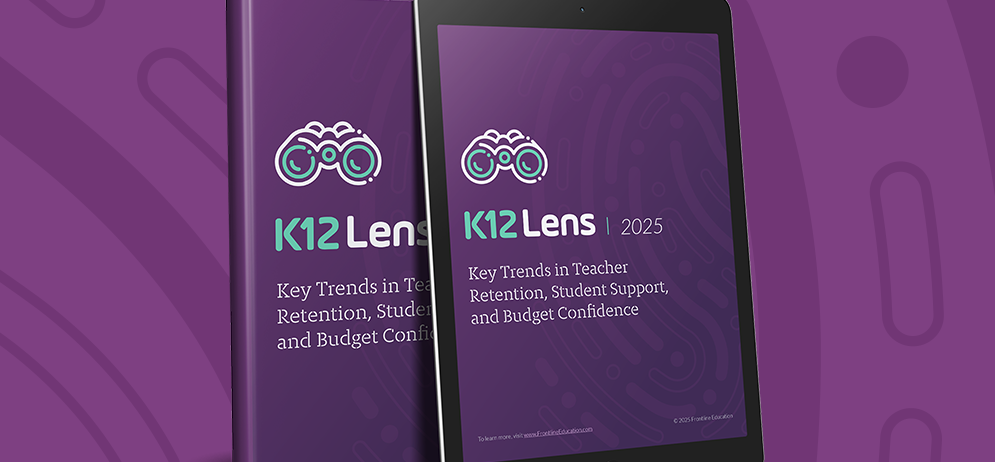Teacher shortages may be easing, but keeping great educators in the classroom remains a challenge. With 78% of teachers staying in their roles on average, districts are searching for ways to strengthen retention—and the data is clear: professional development is one of the most effective strategies.
Our latest K-12 Lens Survey Report, gathering insights from nearly 800 administrators across 49 states, shows that districts investing in mentoring, coaching, and personalized professional learning report higher retention rates and an easier time hiring new educators. In fact, 84% of superintendents who prioritize coaching see better retention outcomes.
So, how can districts use professional development to build a more engaged and stable teaching workforce? Here’s what we found.
Why Professional Development Matters for Teacher Retention
Teachers who feel supported, valued, and have opportunities for continuous development are more likely to stay in their roles. However, not all PD is equally effective. Our survey found that:
- 84% of superintendents who emphasized coaching and mentoring saw above-average retention rates.
- 80% of superintendents who prioritized external conferences reported higher-than-average retention.
- Districts that automate personalized PD recommendations were significantly more likely to report that hiring has become easier.
Districts That Prioritize Certain Types of PD See Better Outcomes
The First Five Years Are Critical
Retention starts before a teacher even steps into their classroom. More districts are rethinking onboarding and induction, shifting from paperwork-driven processes to structured mentoring, personalized PD, and long-term support.
Teachers who have access to a strong professional learning community in their first five years are far more likely to stay. That’s why collaborative PD models, peer learning, and instructional coaching are critical retention strategies.
Hand-picked content for you:
Have you introduced AI learnings or support in your district? Take our instant poll to share.
The Data: How PD Impacts Hiring and Retention
The survey uncovered a direct correlation between professional development and staffing success:
- 32% of districts that automate personalized PD recommendations reported that hiring has become easier.
- Only 4% of districts that do not personalize PD said hiring had improved.
Ease of Recruiting & Hiring Based on Ability to Automate PD Recommendations
At the same time, retention rates vary widely based on how districts prioritize professional learning:
- Urban districts report the lowest retention rate at 70%, often struggling to keep educators.
- Rural districts have the highest retention rate at 85%, likely due to stronger community ties and mentoring programs.
- The national teacher retention rate sits at 78%, with districts that prioritize PD seeing better workforce stability.
Average Retention Rate
Hand-picked content for you:
Easily Managing Teacher-Driven Professional Learning at Haysville USD 261.
What the Most Successful Districts Are Doing
Districts with the highest retention rates have a clear set of professional development strategies that set them apart:
1. Coaching & Mentoring are Game-Changers
Teachers thrive when they have structured, ongoing support. The most successful districts pair new teachers with experienced mentors and offer instructional coaching to reinforce learning.
2. Aligning PD to Teacher Goals and Evaluations
Does your PD system personalize learning based on teacher evaluations and goals? Districts that do see higher engagement and retention.
3. Investing in Collaborative Learning
It’s no secret that teachers want more than passive, one-size-fits-all PD. Professional Learning Communities (PLCs), peer observations, and virtual collaboration tools are making professional learning more engaging and relevant.
4. Making PD Flexible and Accessible
With increasing demands on teachers, flexibility is critical. On-demand videos and blended learning models provide just-in-time PD without disrupting instructional time.
“[Teachers] like the opportunity to choose what they want to learn about and where they want to grow and the things that they’re interested in.”
Heather Platt, Coordinator of Professional Development, Martin County
The HR Factor: Why Professional Development is a Competitive Advantage
HR leaders play a key role in shaping teacher retention by prioritizing professional learning. The data shows that districts with HR-driven PD strategies see better retention outcomes.
- 0% of districts that deprioritize PD alignment reported an easier time with retention.
- 3% of districts that do not measure PD impact said retention had improved.
- 8% of districts that align PD to teacher goals reported stronger retention rates.
The message is clear: Districts that prioritize professional development send a strong signal that they value their educators’ growth—making them more attractive to new hires and more successful in retaining talent.
How Districts Can Strengthen Retention Through PD
If your district is looking to improve retention through professional learning, here are the most effective strategies:
- Invest in coaching and mentoring: It’s the most impactful strategy for retention.
- Align teacher evaluations with PD: Make professional learning personalized and relevant.
- Expand collaborative PD models: Encourage peer learning and PLCs.
- Leverage technology to provide flexible, on-demand learning opportunities.
- Make PD a strategic HR priority: Support teacher growth at every stage of their career, including orientation and onboarding.
By focusing on these strategies, districts can strengthen teacher engagement, reduce turnover, and build a more stable and successful workforce.
Take the Next Step
Want to elevate your district’s professional learning strategy? Explore Frontline Professional Growth to create a professional development program that supports retention, strengthens teacher growth, and drives student success.
Erin Shelton
Erin is a writer and member of the award-winning content team at Frontline Education. With experience in education, she is passionate about creating content that helps to support and impact the growth of both students and teachers.
